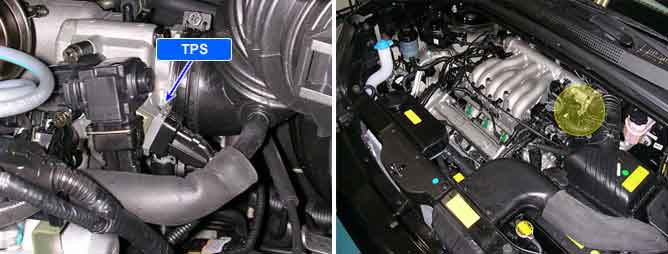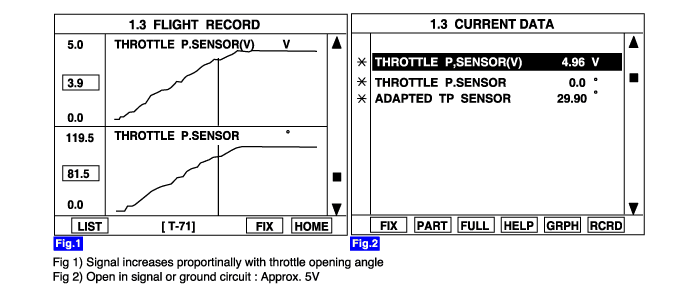

The Throttle Position Sensor (TPS) is mounted on the throttle body and detects the opening angle of the throttle plate. The TPS has a variable resistor (potentiometer) whose characteristic is the resistance changing according to the throttle angle. During acceleration, the TPS resistance between the reference 5V and the signal terminal decreases and output voltage increases; during deceleration, the TPS resistance increases and TPS output voltage decreases. The ECM supplies a reference 5V to the TPS and the output voltage increases directly with the opening of the throttle valve. The TPS output voltage will vary from 0.2~0.8V at closed throttle to 4.3~4.8V at wide-open throttle.
The ECM determines operating conditions such as idle (closed throttle), part load, acceleration/deceleration, and wide-open throttle from the TPS. Also The ECM uses the Mass Air Flow Sensor (MAFS) signal along with the TPS signal to adjust fuel injection duration and ignition timing.
ECM sets DTC P0123 if the ECM detects signal voltage higher than the possible range of a properly operating TPS.
ITEM | DETECTING CONDITION | POSSIBLE CAUSE |
DTC Strategy | ● Voltage range check | ● Open in signal or ground circuit ● Short to battery in signal circuit ● Contact resistance in connectors ● Faulty TP sensor |
Enable Conditions | ● 6 ≤ Battery voltage ≤ 16V | |
Threshold Value | ● Voltage > 4.86V | |
Diagnostic Time | ● 1 sec. |
TPS | Normal parameter | ||
C.T (Idle) | W.O.T | ||
Throttle Angle (°) | 0~0.5° | Approx. 85° | |
Signal Voltage (V) | 0.2~0.8V | 4.3~4.8V | |
Resistance (kΩ) | Terminal 2 and 3 | 0.71~1.38 kΩ at all temperature | 2.7 kΩ at all temperature |
Terminal 1 and 2 | 1.6~2.4 kΩ at all throttle position |
